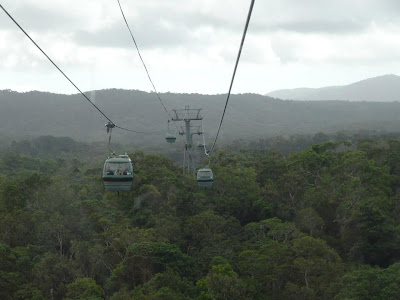Just
inland and over the hills from Cairns and Port Douglas sits the Atherton
Tablelands. Unlike the adjacent area on
the coast, the tablelands are not a rainforest, but instead a plateau with lots
of agricultural activities. And whenever
there is agricultural activity, there is bound to be food. And I like food.
A
lot.
Our
first stop first thing in the morning:
Golden Drop Mango Winery.
Yes,
yes, you read that right. Instead of
grapes, they use mango to make wine, following the same process as usual but
just substituting the fruit. The
result: delicious! They had a range of mango wines – including a
dry wine, sweet wine, and a medium wine in the middle. They even had sparkling and a Port-like
fortified mango wine! What was actually
most interesting was how they prune the trees.
It apparently makes it easier to pick fruit when they cut them this way.
Now,
wine has been known to make me a bit sleepy and the mango wine tasting we had
was no exception, so I had to find a remedy as it was only 10am and we had a
full day ahead of us. Luckily, just up
the road was Jaques Coffee Plantation.
We
got to see coffee berries (coffee comes from berries – who knew?!?!?) and the
machine that they harvest them with.
We
also got to try some coffee and – even better – some coffee liqueurs that they
make. But of course, my eyes went
straight for the prize: tiramisu made with
their very own espresso!
Survey
says: orgasmic. Also orgasmic was Mr Jaques' adult son - wowzers. Unfortunately, I didn't snap a photo because that would have been creepy.
As
if I hadn’t had enough sweets for the day, we passed by the Emerald Creek Ice
Creamery just a few kilometres down the road and it would have been rude not to
sample their macadamia ice cream, right?
Apparently
I’m a risk taker.
But
the day wasn’t all about food for us. We
did take some time to feed others, namely the semi-wild rock wallaby population
at Granite Gorge Nature Park. It was my
sister’s first time feeding these adorable little creatures:
Granite
Gorge also had some great walking/hiking tracks which cross over the massive
boulders that are on the property.
The
next day, we were back in Cairns to catch the Kuranda Scenic Railway. The railway takes tourist up into the hills
and onto the tableland, finishing at the tiny tourist town of Kuranda with
views all along the way.
Kuranda
is located on the border between the tableland and the rainforest and is best
known for its rainforest markets – a place to buy all sorts of trinkets,
souvenirs, art, and more.
After
a bit of shopping around, I spotted some mango ice cream. Again, it would have been rude not to get
some.
I
may have bought some local chocolate and macadamia biscuits too. Kuranda also offers some hiking trails in the
rainforests around the town and along the Barron River.
For
the return trip back to Cairns, we opted for the other main mode of transport
to and from Kuranda: the Skyrail
Rainforest Cableway.
The
Skyrail whisks you above the rainforest canopy and stops at two educational
rainforest boardwalks before taking you back to Cairns.
Overall,
I would most definitely recommend a visit to the Atherton Tablelands for anyone
visiting Cairns. Especially the coffee
plantation. And the mango winery. And the ice creamery.
How
do I not weigh 400 pounds?

























































